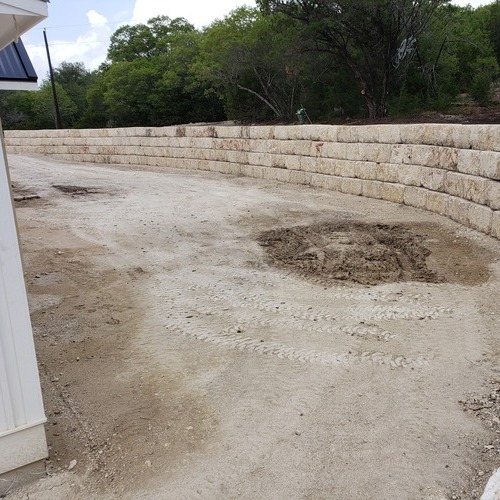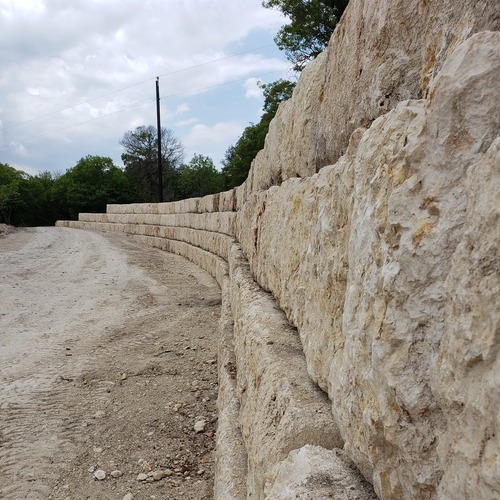
Options for Retaining Walls
If you are planning on building a retaining wall in Clifton / Waco, TX, you have plenty of options available to choose from. What material you choose will depend upon the wall’s purpose, the look you’re going for and your budget. Here are just a few of the most common materials available for retaining walls:
- Concrete block
- Stone veneer
- Poured concrete
- Brick
- Dry stone or boulder
- Gabion
For expert retaining wall installation, you’ll want to choose an experienced contractor. You find those experienced experts at Loftin Dirt Works LLC. You can schedule a service appointment and get your project started today by calling 254-640-1104.
What are the four basic types of retaining walls?
Not only do you have plenty of material options available to build your wall, but you also have options regarding the type of wall you can build. Here are the 4 main types of walls you can put up:
- Gravity: This is the most basic wall. Its weight and mass are what hold soils at bay. These walls are usually made from heavier materials like brick or stone. They may require a trench for installation and a concrete footer to sit on.
- Cantilevered: These walls are fixed to a foundation and supported by steel bars inside the concrete or masonry. The slab foundation goes under the soil and the weight of the soil holds the foundation in place. This type of wall is often built for commercial use.
- Sheet piling: These are also basic walls. They are often composed of either thin sheets of steel, wood or vinyl driven directly into the soil. Extra support is provided by a vertical corrugated structure
- Anchored: Anchored walls can use a variety of fronts that require anchors for support. These anchors are driven into the ground behind the various fronts. The anchors are attached to cables or strips.
What is the most effective retaining wall?
Choice of materials is important when it comes to retaining walls. For the best support, stone, brick or concrete are the best options for retaining walls. For them to be most effective, however, you’ll need to have good drainage.
While you can purchase these materials yourself, it’s not recommended that you try to install them yourself. For the best results, hire a contractor like Loftin Dirt Works LLC who is experienced with masonry work and has installed many walls.
Is a straight or curved retaining wall better?
Retaining walls are usually either straight or curved. There are many things to consider when deciding between a straight or curved wall.
- Aesthetic appeal: While retaining walls have a practical purpose–to help prevent erosion and lend support to foundations–they are put in for aesthetic reasons as well. Most people tend to find curved walls more aesthetically pleasing.
- Amount of add-ons: If you have multiple add-ons like lights or stairs or multicolors, curves can make the wall look busy. Straight walls look best if you plan to have many add-ons.
- Things above the wall: Straight walls are better if you’re installing structures like fences or sheds above the wall. This keeps you from having to build around the curve. On the other hand, if you’re adding flowers or plants above the wall, curves are a good option.
- Location: Will the wall be seen by many people? If it’s not, straight walls may be a good option, especially because straight walls cost less to build. Curved walls, however, often have greater aesthetic appeal.
- Strength: Generally, curved walls are going to be stronger than straight walls.
At what slope should a retaining wall be avoided?
If you are trying to determine whether or not you need a retaining wall, one thing you’ll have to take into consideration is the slope of your soil. The maximum soil slope that is safe is 35 degrees. Any slope that’s greater than that you would want to consider installing a retaining wall.
Of course, you can install a retaining wall to enhance landscaping no matter the slope of your property. Many people often install these walls for that very reason.
Should I use landscape fabric behind a retaining wall?
If you’re working on a wall as a DIY project, landscape fabric is an essential part of a retaining wall. The landscape fabric will create a barrier behind the wall that when filled with gravel will open up an area for water collection and movement. The fabric also helps the voids in the gravel from getting packed with silt.
Make sure to leave room above the gravel fill for topsoil or bedding soil.
What is the easiest retaining wall to install?
If you are planning on building a retaining wall as a DIY project, the easiest material to work with is landscape timber. You only need a few timbers and spikes to build the wall. So few materials also make it the cheapest to install.
The primary disadvantage of wood walls is that they are subject to fungal rot, termites, and water damage.
On the other hand, if you’ve installed the wood wall correctly and keep an eye out for problems like rot or termites, then it could last up to 40 years. Poor installation could see the wall failing in under 5 years.
It’s not recommended to install stone, brick or concrete walls yourself. You’ll get better results hiring a contractor that is experienced with masonry work.
Retaining Wall Installation Near Me
Do you need to protect your property from soil erosion? A retaining wall is often a powerful solution that holds back erosion. These walls are often also aesthetically pleasing additions to landscaping–flowers or plants are often planted above them and the walls can support add-ons like steps or lights. There are many types of walls and many types of materials are available including stone, wood, bricks and concrete.
For expert retaining wall installation in the Clifton / Waco, TX area, you need to look no further than Loftin Dirt Works LLC. Schedule a service with us today by calling our offices at 254-640-1104.


